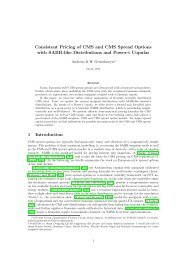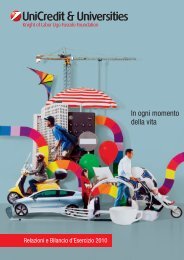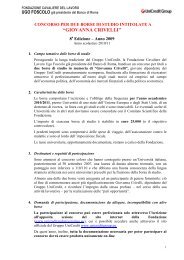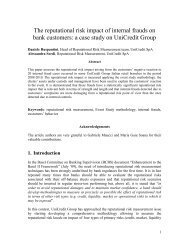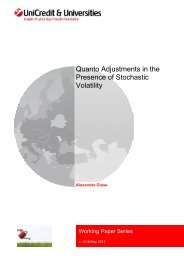Dóra Fazekas Carbon Market Implications for new EU - UniCredit ...
Dóra Fazekas Carbon Market Implications for new EU - UniCredit ...
Dóra Fazekas Carbon Market Implications for new EU - UniCredit ...
Create successful ePaper yourself
Turn your PDF publications into a flip-book with our unique Google optimized e-Paper software.
2.3. Emissions Trading Schemes<br />
Emissions trading systems provide carbon price signals and offer economic incentives to reduce<br />
GHG emissions to covered sectors and installations. Emission trading offers a trading plat<strong>for</strong>m <strong>for</strong><br />
covered sectors; participants reducing emissions below their cap can sell the resulting excess<br />
allowances. In case of deficit at a company or at national level sources are motivated to reduce their<br />
emissions. Facilities are thus encouraged to reduce their emissions assuming it is less costly than to<br />
buy extra quotas on the market (Montgomery, 1972). All this inspires firms to reduce their<br />
emissions and to save allowances and potentially to realize extra profit.<br />
According to Raymond Kopp (2007) all cap-and-trade systems have the followings in common:<br />
(1) a cap on annual emissions is established,<br />
(2) regulated entities are identified;<br />
(3) one allowance is required <strong>for</strong> each tonne of emissions;<br />
(4) allowances are freely transferable;<br />
(5) allowances are initially distributed through free allocation, or sold through an auction.<br />
The economics literature is extensive with discussions of what makes emissions trading programs<br />
effective. Successful emissions trading programs<br />
(1) monitor emissions and en<strong>for</strong>ce the requirement to surrender allowances equal to those;<br />
(2) allocate emissions allowances in a way that is simple, transparent, and equitable<br />
(3) ensure liquidity within and across time periods, moderate volatility and promote innovative<br />
behavior.<br />
A number of emissions trading schemes exist, have been announced or proposed recently all over<br />
the world. Beginning in 2005 the European Union launched its cap-and-trade program <strong>for</strong><br />
greenhouse gases. In general, the design of <strong>EU</strong> ETS builds upon the lessons of the economics<br />
literature and the experience of earlier emissions trading programs. However, the scope and<br />
complexity of the <strong>EU</strong> program is far greater than past ef<strong>for</strong>ts. Because of its scope and<br />
multijurisdictional political structure and because it is the first large-scale attempt to regulate<br />
greenhouse gases the <strong>EU</strong> ETS passes existing US trading programs in size and complexity and<br />
includes a variety of <strong>new</strong> features. As such, it has the opportunity to advance the role of market-<br />
based policies in environmental regulation and to <strong>for</strong>m the basis <strong>for</strong> future European and<br />
international climate change policies.<br />
30



